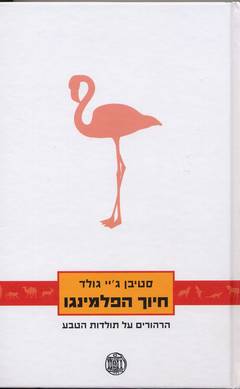Dvir Publishing, 2005, 414 pages, translated by Naomi Carmel. Scientific editing: Dr. Avi Arbel
Avi Blizovsky

No, that's not a mistake. Stephen J. Gold died in 2002 but his legacy included several more books that have not yet been translated into Hebrew and as happened in the case of the late Carl Sagan, here too it is good that the Hebrew reader is allowed to close gaps with his English speaking colleague.
Like all his other books, this book is also based on columns that appeared individually in one or another popular periodical, so there is not always a sequence between them, but the topics it deals with, and the ideas it tries to promote are similar.
One of the topics is the analysis of the scientific opinions of the creationists before Darwin - who simply tried to explain the world according to the knowledge they had at the time. There were some of them who, after realizing the significance of Darwin's discovery and after, according to the best scientific tradition, sought to perform experiments to prove their claim, and these experiments failed, they admitted failure and moved to the other side.
The problem is that some of the claims made by creationists today are similar to those made then, and today's creationists refuse to accept the refutations that changed the minds of creationists back then.
For example, for generations the fossils were considered remnants of Noah's flood. Later, with the development of geology, it became clear that not all fossils are of the same age, and that, at least as far as northern Europe is concerned, many animals simply froze when the giant glacier covered the continent. Added to this was the debate surrounding the age of the Earth, which even in Darwin's time was no more than a few tens of millions of years (because the phenomenon of radioactivity, which drives the sun for billions of years, was unknown then and all other explanations could not cover more than millions of years).
The book gets its name from the article that bears that name and reveals to us interesting things about the chicken that no zoo can be called a zoo if it is not in it. This chicken was loved by the Roman emperors, or rather its fleshy tongue, but what is more interesting is that this tongue comes from an unusual way of eating - turning the head and beak, and filtering the small molluscs, small crabs and insect larvae. Flamingos pass water through their beak filters in two ways - either by shaking their heads back and forth, letting the water flow through them passively, or by using an active pump that is operated by a large and strong tongue. The tongue fills a large canal in the lower beak, it moves quickly backwards and forwards, up to four times per second, draws water through the filters in its backward movement and emits it in its forward movement. Flamingos also eat with their heads upside down. They stand in shallow water, swinging their heads down to the level of their feet, gently adjusting their head position to the length of the S-curve of the neck or its shortening. This movement, of course, changes the position of the head, which changes the conventional function of the parts of the beak while eating. The upper anatomical beak of the flamingo is placed below and serves, functionally, as the lower jaw. The lower anatomical beak stands up, in the position where the upper beaks are found in almost all other birds.
The result of all this, that when the flamingo is not eating, it looks like a smiling swan. This dramatic perceptual shift from a happy swan to a haughty flamingo (if you flip the image) recalls every standard detail in the psychological storehouse of optical illusions - especially the young lady dressed in vests and looking off into the distance who laterally becomes the old witch. Virtually any accurately drawn picture of a flamingo creates this impressive fact when viewed upside down and for obvious reasons, the evolution of the jaws adapted them to their upside down role. The upper jaw of the flamingo really looks like the lower beak of a typical chicken and so we see the flamingo with its head turned not as absurd but only as a somewhat strange swan-like bird.
These strange phenomena of nature are a well-known and familiar device in Gould.
What's funny is that despite Gould's opposition to creationists they find one part of his teaching to be the source of much spoil. He is an enthusiastic supporter of the catastrophe theory - that is, that in the course of evolution, direction (or rather misdirection) is generally determined during major catastrophes and less so by natural selection operating all the time when if there is apparently evidence of slow extinctions before a large extinction it is due to various biases of nature such as a drop in level The sea water that disrupts the fossilization.
The natural selection that causes the creation of new species works according to Gold (in the last chapter of the book) until all the niches are filled, and this also takes tens of millions of years after each catastrophe. This is in contrast to other scientists who claim that evolution works non-stop. Both are probably right.
In any case, Gold is no longer with us to defend his ideas, but his books will still remain relevant, as long as there are people who, unlike the well-intentioned creationists before Darwin, will have different intentions, and since the arguments they make refuse to become obsolete, so will the reactions to them, such as these of Gold, will remain topical.
